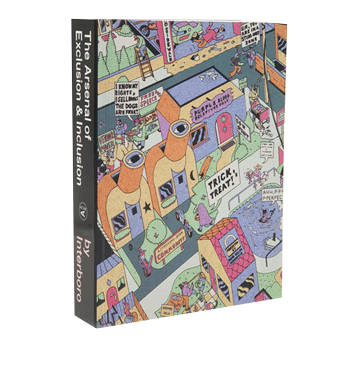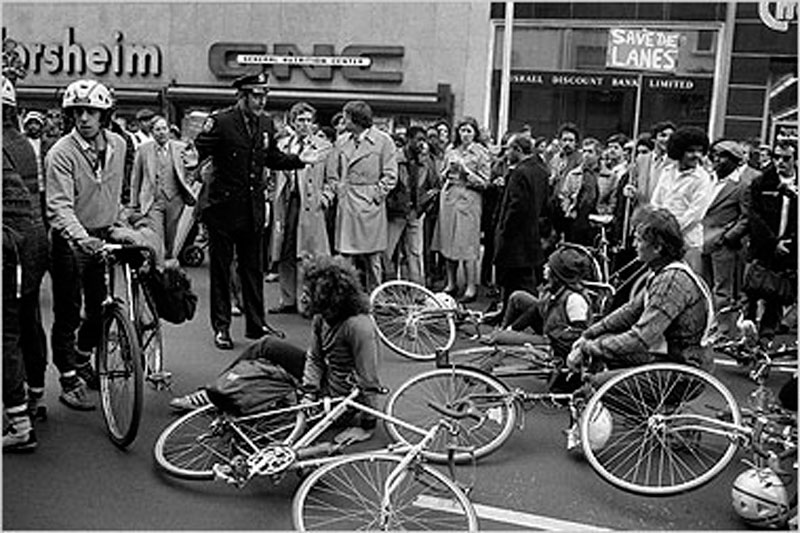Things are looking optimistic for cyclists in American cities. To start, their population is growing: the number of bicycle commuters increased by more than 60 percent in the first decade of the 21st century.1 Concurrently, municipal governments are investing on an unprecedented scale in bicycle infrastructure. It’s no longer shocking to hear the mayors of major American cities, such as Memphis or Washington, deliver impassioned speeches about the virtues of bike lanes. Chicago alone is planning 645 miles of on-street bikeways by 2020.2 Many of these efforts are informed by quasi-economics, with sources such as urbanist Richard Florida and Bloomberg Businessweek proclaiming that bike-friendly cities attract pools of well-educated millennial labor.3 Others point to bike lanes as a way to combat rising obesity rates and create healthier urban publics. Additionally, growing awareness of impending ecological crises is pushing (some) cities to prove their sustainability chops with high-profile “green initiatives,” e.g., bike-sharing programs and bike-lane networks.
Bike lanes increase safe access to city streets for people on bikes. Safe access, in turn, produces more cyclists: studies have shown that the most effective way to increase ridership is to simply build more bike lanes.1 But with bicycling acquiring new social, economic, and political meanings in recent years, bike lanes have also sparked debates over local control of public space, as this anecdote from Brooklyn illustrates. Other controversies involving bike lanes in New York City centered on Prospect Park West in Brooklyn (pitting residents of Bay Ridge and the borough presidents against residents of Park Slope and the Department of Transportation) and Grand Street in Manhattan (igniting the collective anger of the Little Italy Restoration Association, the Chinese Consolidated Benevolent Association, and the SoHo Alliance). These tensions have been particularly acute in majority working-class neighborhoods undergoing rapid gentrification, where the installation of bike lanes is sometimes perceived as serving the needs of affluent outsiders at the expense of more established communities (for example, by obstructing industrial activity, attracting more gentrifiers, and driving real estate speculation).
In the Arsenal, you can find other weapons that relate to transportation, such as Americans with Disabilities Act, Bridge, Campus Shuttle, Elevator, Flat Fare, Freeway, No-Cruising Zone, One-Way Street, and Farmers Market.
Despite these trends, cycling activists would like to move a whole lot faster,4 and some are taking matters into their own hands. In Seattle, an anonymous group called Reasonably Polite Seattleites installed $350 worth of plastic pylons onto a dangerous bike lane, thereby demarcating it from car traffic. Its guerilla activism paid off: a city traffic engineer responded with his own very polite message, promising to install similar posts around the city and even thanking the group for its “thoughtful demonstration.”5
The remnants of a guerilla bike lane on Bedford Avenue in Brooklyn, New York. (Courtesy of Lynley Bernstein)
Such activism was less well received in the Williamsburg section of Brooklyn, New York—a neighborhood known both for its longstanding community of Hasidic Jews and, more recently, as an epicenter of hipster culture. Dissonance between these two (very generalized) populations came to a head over bike lanes built under the administration of Mayor Michael Bloomberg in the mid to late 2000s. According to some members of the Hasidic community, the new Williamsburg lanes caused parking problems and, more gravely, constituted a “safety and religious hazard” because 1) the bike lanes attracted swarms of bicyclists who disregarded traffic laws, thus endangering children exiting their school buses, and 2) women riding by in “shorts and skirts” caused discomfort among Hasidic men, who are prohibited from looking at improperly dressed members of the opposite sex.6 “I have to admit,” local community board member Simon Weisser told The New York Post, “it’s a major issue, women passing through here in that dress code. It bothers me, and it bothers a lot of people.”7
Despite these concerns from Williamsburg’s Hasidic community, the city government remained silent on the topic. Then, in late 2009, its Department of Transportation abruptly announced that it would sandblast 14 blocks of bike lane on Bedford Avenue, the neighborhood’s main thoroughfare, into oblivion. This was a rare move from an unprecedentedly bike-friendly administration, but rumor had it that Bloomberg, in his latest bid for re-election, had offered this minor concession in the hopes of receiving the Hasidic bloc vote. Regardless of the motives, biking on Bedford was now substantially less convenient, as well as more dangerous.
Bicycling activists protest Mayor Ed Koch’s 1980 removal of the bike lanes his administration had constructed earlier that year.
Within a few days, however, a stretch of the bike lane was back: three local activists had redrawn it in the middle of the night with stencils and aerosol cans. Two nights later, their attempt at reviving the remaining section of the bike lane ended with encirclement by a Shomrim patrol (the Hasidic voluntary police) and brief interrogation by confused NYPD officers. “We were touching up the bike lane,” the activists told the cops. Initially, they were let off the hook, but that changed following the YouTube debut of “Repainting the Bike Lane on Bedford Avenue” (which to date has about 175,000 views). Two of the activists were charged with criminal mischief and asked to turn themselves in. Most importantly, the bike lane was again removed by the city. As of this writing, the erased bike lane on Bedford has not been repainted.8
Bonus Material:
Bicycle “Scorchers” on the Lower East Side
The modern bicycle has long been a source of contention in New York City. At the turn of the 20th century, it was a major fashion statement for middle- and upper-class consumers, yet it remained prohibitively expensive for the urban poor.1 Historian Clay McShane’s Down the Asphalt Path: The Automobile and the American City describes the era’s tensions between working-class residents of Manhattan’s Lower East Side and the uptown cyclists whose commutes ran through their streets. The Lower East Side was then the most densely populated neighborhood on Earth, and because it contained no parks or playgrounds, the street functioned as the sole recreational space for children. Unsurprisingly, encroachment on their territory by well-to-do bicycle commuters was not taken lightly. Some children responded to the influx by “sprinkling glass on the street” and “stoning bicycle ‘scorchers.’”2 Even the local Socialist Party took a stance against paving downtown streets, hoping to deter the uptown cyclists. McShane writes, “One Lower East Side historian interviewed a woman whose oldest memory was being run down in the 1890s by ‘a well dressed man on a bicycle,’ apparently on his way to Wall Street. He lectured this four-year-old about playing in the street rather than helping her. Eighty years later, she still burned with resentment.”3
The Revolution of 1987
Three-term New York City Mayor Ed Koch was initially an outspoken proponent of bike lanes. While still a United States congressperson in 1973, he wrote to a constituent, “If the City is to establish a balanced, efficient and clean transportation system, the bicycle must be included as an integral project.” In 1980, inspired by the thousands of bicycle commuters he saw while visiting Beijing, his administration introduced protected bike lanes on Fifth, Sixth, and Seventh Avenues and Broadway Street in Manhattan. The experiment didn’t last long. That same year, the city tore them up, caving to critics who declared the lanes unpopular, unsafe for pedestrians, and a burden on traffic. The cyclist community protested to no avail. Seven years later, in an attempt to crack down on the city’s growing population of notoriously lawless bike messengers, Koch banned bicycling outright on Midtown avenues except Sixth between 10 AM and 4 PM on weekdays. This time, hundreds of bicycle commuters, messengers, and recreational riders collectively took to the streets in protest, riding at five miles per hour through Manhattan. These demonstrations would later be remembered among bicycle activists as the Revolution of 1987. As a final setback to the Koch Administration, the Supreme Court of the State of New York invalidated the ban because the city had failed to publish an official notice and institute a 45-day notice period. The city decided against reviving it.




















